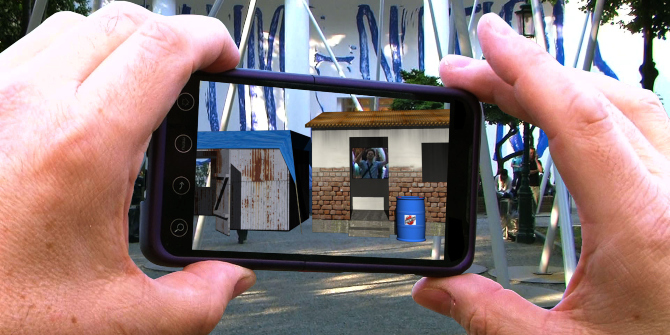
In 2016, the Holocaust Memorial Museum in Washington D.C. asked people to stop playing Pokémon GO inside the museum; having players trying to catch Pokémon detracted from the somber material the museum displayed. While Pokémon GO was one of the first uses of augmented reality to capture the public imagination, the technology is increasingly common in both business and home settings. Currently augmented reality is not strongly regulated – if a person wishes to augment a particular physical space, they can. But maybe that should change. Is it truly acceptable to have people catching Pokémon at the Holocaust Museum? What if someone created an app that would allow people to know the religion of residents simply by walking past their homes? These are the sorts of ethical questions we need to face as augmented reality becomes more prevalent.
Augmented reality uses technology to project digital content on to our experience of the physical world; that content depends on the surrounding space, so you will see different virtual things in different physical places. The most common way of implementing this at present is via a specific application on your phone. In this case, augmentations are spread across different applications. If you want to play a game, you bring up the Pokémon GO app. If you want to visualise how a sofa will look in your home, you bring up the IKEA app. However, many people envision an integrated form of augmented reality, typically via wearable technology such as glasses. In this case the digital content would be superimposed on your experience of the world. This has the potential to make augmented reality a more seamless experience.
The way augmented reality develops affects our ethical obligations. Consider the case of private property. In the single sphere case, augmentations are visible to anyone using augmented reality. So if someone augments my house, that may interfere with my use of the property. This is like having someone stick a sign in my front yard supporting a political candidate. I may not want that sign because I may endorse a different candidate. I may not want signs in my yard at all because I think they are ugly. Either way, I am generally entitled to remove the sign, because it is my property and my use of that property trumps the use of others. This holds true for augmentations, too – it doesn’t matter whether you stick a virtual or a physical sign on my yard. Your use is interfering with mine and, as the property owner, I win.
If the augmentation occurs over multiple apps, this argument becomes much weaker. It is not clear that your augmentation will interfere with my ability to use my property unless we are both using the same app. Niantic may place Pokémon in my yard, but that is not going to interfere with my app listing interesting historical facts about my property. There are limits – you likely could not augment someone’s house with, say, virtual slurs – but augmenting other people’s property is more ethically acceptable in this case.
Hard questions remain, such as whether it would be wrong to augment people’s residences with information about their religion. This is not necessarily an invasion of privacy; if a house has a mezuzah by their front door, anyone who walks by has some reason to think that the family is Jewish. It seems clear that creating an app with anti-Semitic intentions so as to single out Jewish people would be obviously unethical (and thus the augmentations would themselves be unethical). It is less clear how to judge an app that simply notes the religions of people occupying houses in a neighborhood, perhaps for census purposes. It could certainly be used for bad purposes, but it wouldn’t have to be.
Similarly, it may be permissible to create an app that superimposes explicit sexual images on the world. Augmenting a day care with those images seems problematic, however; it is not the content itself but the juxtaposition of the content and location. This is despite the fact that the children would likely not have access to those images and the app need not interfere with the day care’s business. Nonetheless, the association of sex with small children is something that most societies frown on; while the augmentation may not be causing harm exactly, the particular location seems inappropriate. Even in the multiple application case, there are hard cases for private property.
For public property, the multiple app case is fairly straightforward and akin to having a variety of travel guides. There are many to choose from, depending on your purposes, and the fact that Lonely Planet makes a guide for London does not prevent Fodor from making one as well. From an ethical standpoint, the main question becomes whether the augmentation unduly interferes with the intended use of the space – this is where Pokémon GO originally fell down (although they subsequently implemented some changes), since the Holocaust Memorial Museum found that players were interfering with the experiences of museum patrons.
The single sphere case is more complex. Much will depend on whether we treat augmentations more like speech or more like graffiti. If we treat augmentations as speech, then presumably we will largely wish to preserve this right. The state cannot dictate what conversations are permissible to have in Trafalgar Square, and the same could be true of augmentations. If we treat augmentations as graffiti, the state has more control over them. Unless created by Banksy, graffiti is not generally seen as something which benefits the public; it is viewed as a nuisance and subject to erasure.
Part of the problem is that augmentations will likely be some of each of these. Augmenting public places with photos of someone’s genitals seems akin to graffiti. Augmenting a place with historical information seems more like speech. As for augmenting a museum to state that their café serves terrible coffee – that seems to be in the eye of the beholder.
♣♣♣
Notes:
- This blog post is based on the author’s paper Augmented Reality, Augmented Ethics: Who Has the Right to Augment a Particular Physical Space? in Ethics and Information Technology.
- The post gives the views of its author, not the position of LSE Business Review or the London School of Economics.
- Featured image by BagoGames, under a CC-BY-2.0 licence
- Before commenting, please read our Comment Policy
 Erica L. Neely is an associate professor of philosophy at Ohio Northern University specialising in the philosophy of technology and computer ethics. She has two main threads to her research. The first of these is a focus on the ethical ramifications of emerging technologies such as augmented reality. Her other main area of research interest is on ethical issues pertaining to video games; this includes both the ways in which video games attempt to represent moral dilemmas and the ethical responsibilities of members of the video game community. Erica holds a B.A. in Mathematical Sciences from the University of Oxford and an M.A. and Ph.D. in Philosophy from the University of Illinois at Urbana-Champaign.
Erica L. Neely is an associate professor of philosophy at Ohio Northern University specialising in the philosophy of technology and computer ethics. She has two main threads to her research. The first of these is a focus on the ethical ramifications of emerging technologies such as augmented reality. Her other main area of research interest is on ethical issues pertaining to video games; this includes both the ways in which video games attempt to represent moral dilemmas and the ethical responsibilities of members of the video game community. Erica holds a B.A. in Mathematical Sciences from the University of Oxford and an M.A. and Ph.D. in Philosophy from the University of Illinois at Urbana-Champaign.






1 Comments